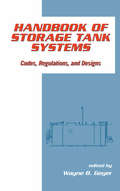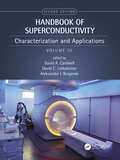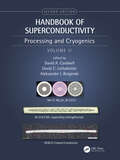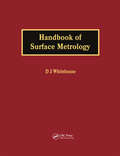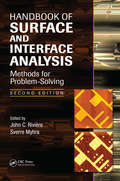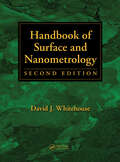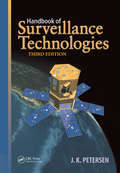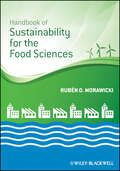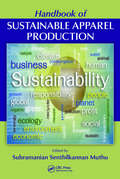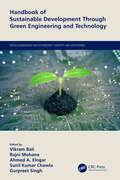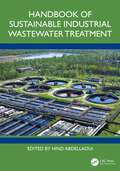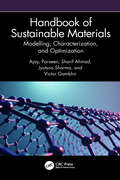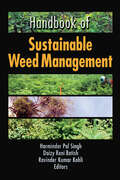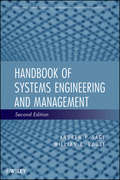- Table View
- List View
Handbook of Stimuli-Responsive Materials
by Marek W. UrbanAdopting a broad approach, this volume provides the scientific community with a much-needed overview of developments and scientific findings in stimuli-responsive materials. Its primary focus is on the designing, synthesizing, formulating, and processing of materials that lead to an understanding of the scientific principles governing response driven functions leading to future technologies. The highly experienced and internationally renowned editor has assembled a team of leading scientists from the interdisciplinary areas of: * polymers * biopolymers * biochemistry * biophysics * biomaterials * bioengineering * materials engineering * biotechnology * chemistry * physics * ceramics * metals * and materials science. A combination that guarantees a unique and high-quality handbook.
Handbook of Storage Tank Systems: Codes: Regulations, and Designs
by Wayne B. GeyerThis timely reference surveys manufacturing and installation methods, standards, and specifications of factory-made steel storage tanks and appurtenances for petroleum, chemicals, hydrocarbons, and other flammable or combustible liquids. It chronicles the trends toward secondary containment, aboveground storage tanks, and corrosion-resistant underground steel storage systems. Written by over 20 leading experts in industry, this handbook discusses relevant fire safety and building codes, construction specifications, and environmental regulations, making it a valuable asset for chemical, pollution, environmental, industrial, mechanical, and civil engineers, to name only a few.
Handbook of Structural Engineering
by Wai-Fah Chen Eric M. LuiContinuing the best-selling tradition of the Handbook of Structural Engineering, this second edition is a comprehensive reference to the broad spectrum of structural engineering, encapsulating the theoretical, practical, and computational aspects of the field. The contributors cover traditional and innovative approaches to analysis, design, and rehabilitation. New topics include: fundamental theories of structural dynamics; advanced analysis; wind- and earthquake-resistant design; design of prestressed structures; high-performance steel, concrete, and fiber-reinforced polymers; semirigid frame structures; structural bracing; and structural design for fire safety.
Handbook of Structural Life Assessment
by Raouf A. IbrahimThis important, self-contained reference deals with structural life assessment (SLA) and structural health monitoring (SHM) in a combined form. SLA periodically evaluates the state and condition of a structural system and provides recommendations for possible maintenance actions or the end of structural service life. It is a diversified field and relies on the theories of fracture mechanics, fatigue damage process, and reliability theory. For common structures, their life assessment is not only governed by the theory of fracture mechanics and fatigue damage process, but by other factors such as corrosion, grounding, and sudden collision. On the other hand, SHM deals with the detection, prediction, and location of crack development online. Both SLA and SHM are combined in a unified and coherent treatment.
Handbook of Supercapacitor Materials: Synthesis, Characterization, and Applications
by Rajender BoddulaDiscover foundational and cutting-edge concepts in the supercapacitor materials industry Dramatic population growth and the development of lightweight portable electronic devices have accelerated the demand for faster and more sustainable energy storage systems. Supercapacitors promise to revolutionize the field due to their high energy and power density, long cycle life, fast rate of charge-discharge, and excellent safety record. In Handbook of Supercapacitor Materials: Synthesis, Characterization, and Applications, a distinguished team of researchers delivers a comprehensive review of nature-inspired, organic, inorganic, and polymeric materials used in supercapacitor technology. The book explores aspects of synthesis methods, properties, foundational concepts, and the mechanisms of supercapacitor electrode materials. The distinguished editors also provide resources that focus on supercapacitor performance utilizing electrical double layer electrodes and pseudocapacitor electrodes. State-of-the-art research is discussed in detail and will be extraordinary useful for graduate students, faculty, engineers, and scientists in solid-state chemistry, energy science, and materials science departments. Readers will also find: Overviews of mussel-inspired materials for electrochemical supercapacitors, bio-inspired active materials for supercapacitors, and self-healing supercapacitors Practical discussions of polysaccharide-derived materials for supercapacitors, bio-derived carbon-based materials for supercapacitors, and metal oxides A thorough introduction to metal chalcogenides and metal hydroxides for supercapacitors An examination of template strategy direction towards conducting polymer for supercapacitors A treatment of the morphology paradigm of conducting polymers Perfect for materials scientists, electrochemists, engineers in power technology, Handbook of Supercapacitor Materials: Synthesis, Characterization, and Applications is also a must-have resource for professionals working in the electrotechnical and automobile industries.
Handbook of Superconductivity: Characterization and Applications, Volume Three
by David A. Cardwell David C. Larbalestier Aleksander I. BraginskiThis is the last of three volumes of the extensively revised and updated second edition of the Handbook of Superconductivity. The past twenty years have seen rapid progress in superconducting materials, which exhibit one of the most remarkable physical states of matter ever to be discovered. Superconductivity brings quantum mechanics to the scale of the everyday world. Viable applications of superconductors rely fundamentally on an understanding of these intriguing phenomena and the availability of a range of materials with bespoke properties to meet practical needs.While the first volume covers fundamentals and various classes of materials, the second addresses processing of these into various shapes and configurations needed for applications, and ends with chapters on refrigeration methods necessary to attain the superconducting state and the desired performance. This third volume starts with a wide range of methods permitting one to characterize both the materials and various end products of processing. Subsequently, diverse classes of both large scale and electronic applications are described. Volume 3 ends with a glossary relevant to all three volumes. Key Features: Covers the depth and breadth of the field Includes contributions from leading academics and industry professionals across the world Provides hands-on familiarity with the characterization methods and offers descriptions of representative examples of practical applications A comprehensive reference, the handbook is suitable for both graduate students and practitioners in experimental physics, materials science, and multiple engineering disciplines, including electronic and electrical, chemical, mechanical, metallurgy and others.
Handbook of Superconductivity: Fundamentals and Materials, Volume One
by David A. CardwellThis is the first of three volumes of the extensively revised and updated second edition of the Handbook of Superconductivity. The past twenty years have seen rapid progress in superconducting materials, which exhibit one of the most remarkable physical states of matter ever to be discovered. Superconductivity brings quantum mechanics to the scale of the everyday world where a single, coherent quantum state may extend over a distance of metres, or even kilometres, depending on the size of a coil or length of superconducting wire. Viable applications of superconductors rely fundamentally on an understanding of this intriguing phenomena and the availability of a range of materials with bespoke properties to meet practical needs. This first volume covers the fundamentals of superconductivity and the various classes of superconducting materials, which sets the context and background for Volumes 2 and 3. Key Features: Covers the depth and breadth of the field Includes contributions from leading academics and industry professionals across the world Provides hand-on guidance to the manufacturing and processing technologies A comprehensive reference, this handbook is suitable for both graduate students and practitioners in experimental physics, materials science and multiple engineering disciplines, including electronic and electrical, chemical, mechanical, metallurgy and others.
Handbook of Superconductivity: Processing and Cryogenics, Volume Two
by David A. CardwellThis is the second of three volumes of the extensively revised and updated second edition of the Handbook of Superconductivity. The past twenty years have seen rapid progress in superconducting materials, which exhibit one of the most remarkable physical states of matter ever to be discovered. Superconductivity brings quantum mechanics to the scale of the everyday world where a single, coherent quantum state may extend over a distance of metres, or even kilometres, depending on the size of a coil or length of superconducting wire. Viable applications of superconductors rely fundamentally on an understanding of this intriguing phenomena and the availability of a range of materials with bespoke properties to meet practical needs. While the first volume covers the fundamentals of superconductivity and the various classes of superconducting materials, Volume 2 covers processing of the desired superconducting materials into desired forms: bulks, films, wires and junction-based devices. The volume closes with articles on the refrigeration methods needed to put the materials into the superconducting state. Key Features: Covers the depth and breadth of the field Includes contributions from leading academics and industry professionals across the world Provides hands-on guidance to the manufacturing and processing technologies A comprehensive reference, the handbook is suitable for both graduate students and practitioners in experimental physics, materials science, and multiple engineering disciplines, including electronic and electrical, chemical, mechanical, metallurgy and others.
Handbook of Surface Metrology
by David J. WhitehouseWritten by the leading authority in the subject, Handbook of Surface Metrology covers every conceivable aspect of measuring and characterizing a surface. Focusing both on theory and practice, the book provides useful guidelines for the design of precision instruments and presents data on the functional importance of surfaces. It also clearly explains the essential theory relevant to surface metrology. The book defines most terms and parameters according to national and international standards. Many examples and illustrations are drawn from the esteemed author's large fund of groundbreaking research work. This unparalleled, all-encompassing "metrology bible" is beneficial for engineering postgraduate students and researchers involved in tribology, instrumentation, data processing, and metrology.
Handbook of Surface and Colloid Chemistry
by K. S. BirdiThis new edition of the Handbook of Surface and Colloid Chemistry informs you of significant recent developments in the field. It highlights new applications and provides revised insight on surface and colloid chemistry's growing role in industrial innovations. The contributors to each chapter are internationally recognized experts. Several chapter
Handbook of Surface and Interface Analysis: Methods for Problem-Solving, Second Edition
by John C. Rivière Sverre MyhraThe original Handbook of Surface and Interface Analysis: Methods for Problem-Solving was based on the authors' firm belief that characterization and analysis of surfaces should be conducted in the context of problem solving and not be based on the capabilities of any individual technique. Now, a decade later, trends in science and technology appear
Handbook of Surface and Nanometrology
by David J. WhitehouseSince the publication of the first edition, miniaturization and nanotechnology have become inextricably linked to traditional surface geometry and metrology. This interdependence of scales has had profound practical implications.Updated and expanded to reflect many new developments, Handbook of Surface and Nanometrology, Second Edition determines h
Handbook of Surveillance Technologies
by J.K. Petersen Pamela TaylorFrom officially sanctioned, high-tech operations to budget spy cameras and cell phone video, this updated and expanded edition of a bestselling handbook reflects the rapid and significant growth of the surveillance industry. The Handbook of Surveillance Technologies, Third Edition is the only comprehensive work to chronicle the background and curre
Handbook of Sustainability for the Food Sciences
by Rubén O. MorawickiMany books on sustainability have been written in the last decade, most of them dealing with agricultural systems, communities, and general business practices. In contrast, Handbook of Sustainability for the Food Sciences presents the concept of sustainability as it applies to the food supply chain from farm to fork but with a special emphasis on processing. Structured in four sections, Handbook of Sustainability for the Food Sciences first covers the basic concepts of environmental sustainability and provides a detailed account of all the impacts of the food supply chain. Part two introduces the management principles of sustainability and the tools required to evaluate the environmental impacts of products and services as well as environmental claims and declarations. Part three looks at ways to alleviate food chain environmental impacts and includes chapters on air emissions, water and wastewater, solid waste, energy, packaging, and transportation. The final part summarizes the concepts presented in the book and looks at the measures that will be required in the near future to guarantee long term sustainability of the food supply chain. Handbook of Sustainability for the Food Sciences is aimed at food science professionals including food engineers, food scientists, product developers, managers, educators, and decision makers. It will also be of interest to students of food science.
Handbook of Sustainable Apparel Production
by Subramanian Senthilkannan MuthuA hot-button societal issue, sustainability has become a frequently heard term in every industrial segment. Sustainability in apparel production is a vast topic and it has many facets. Handbook of Sustainable Apparel Production covers all aspects of sustainable apparel production including the raw materials employed, sustainable manufacturing proce
Handbook of Sustainable Development Through Green Engineering and Technology (Green Engineering and Technology)
by Gurpreet Singh Ahmed A. Elngar Vikram Bali Sunil Kumar Chawla Rajni MohanaGreen engineering involves the designing, innovation, and commercialization of products and processes which promote sustainability without eliminating both efficiency and economic viability. This handbook focuses on sustainable development through green engineering and technology. It is intended to address the applications and issues involved in their practical implementation. A new range of renewable-energy technologies, modified to provide green engineering, will be described in this handbook. It will explore all green technologies required to provide green engineering for the future.These include, but are not limited to, green smart buildings, fuel-efficient transportation, paperless offices, and many more energy-efficient measures. Handbook of Sustainable Development through Green Engineering and Technology acts as a comprehensive reference book to use when identifying development for programs and sustainable initiatives within the current legislative framework. It aims to be of great interest to researchers, faculty members, and students across the globe.
Handbook of Sustainable Development and Leisure Services (World Sustainability Series)
by Walter Leal Filho Adrian Lubowiecki-Vikuk Bruno Miguel Barbosa de Sousa Bojan M. ĐerčanThis book reviews empirical and theoretical research on sustainable development in the context of leisure management for communities. Although leading research centers are pursuing interdisciplinary research on leisure in the context of sustainable development, there are still few papers that holistically address the current challenges in this area. In addition, demographic changes have made the promotion of a healthy lifestyle essential. Doing so requires responsible behavior on the part of various stakeholders in this market.This book fills an important gap in the literature and gathers contributions from an interdisciplinary and international team of authors, whose fields of expertise include human geography, management, intersections of sustainability and leisure, behavioral psychology and tourism.
Handbook of Sustainable Industrial Wastewater Treatment
by Hind AbdellaouiThe Handbook of Sustainable Industrial Wastewater Treatment is an indispensable resource for addressing the pressing challenges of wastewater management through innovative and sustainable technologies. This comprehensive guide delves into the intricacies of pollutant classification, the impacts of climate change, and a variety of effective treatment methods, making it a must-have for professionals in the field.This handbook equips readers with the essential knowledge to maintain efficient water treatment systems while implementing sustainable practices that prioritize environmental protection. It showcases cutting-edge treatment technologies capable of removing over 99% of contaminants, all while minimizing maintenance needs, energy consumption, and chemical usage. By offering eco-friendly solutions that significantly reduce operational costs, this handbook emerges as a vital tool for enhancing wastewater management practices across industries.In addition to traditional methods, this handbook explores innovative strategies that not only improve water quality but also promote resource conservation, ultimately supporting broader environmental sustainability goals. Tailored specifically for researchers, academicians, and professionals in hydrology, environmental science, agricultural engineering, and water resource management, this handbook also benefits postgraduate and doctoral students engaged in water-related research.
Handbook of Sustainable Materials: Modelling, Characterization, And Optimization
by Ajay Parveen Sharif Ahmad Jyotsna Sharma Victor GambhirHandbook of Sustainable Materials presents recent developments in sustainable materials and how these materials interact with the environment. It highlights the recent advancements involved in proper utilization of sustainable materials, including chemical and biological approaches. With chapters written by global experts, the book offers a guide and insights into sustainable materials from a variety of engineering disciplines. Each chapter provides in-depth technical information on the sustainable materials theory and explores synthesis strategies, green materials, and artificial intelligence. The book considers applications in sectors such as aerospace, automobile, and biomedical for rapid prototyping and customized production without negative environmental impacts. It features research outcomes and case studies of optimization and modeling techniques in practice. Features: Presents recent developments in sustainable materials from various engineering fields and industry applications. Emphasizes analytical strategies, computational, and simulation approaches develop innovative sustainable materials. Discusses an artificial intelligence approach, rapid prototyping, and customized production. This book is designed for researchers and professionals working with sustainable materials, clean manufacturing, and environmental impacts.
Handbook of Sustainable Polymers for Additive Manufacturing
by Antonio PaesanoThis book provides the latest technical information on sustainable materials that are feedstocks for additive manufacturing (AM). Topics covered include an up-to-date and extensive overview of raw materials, their chemistry, and functional properties of their commercial versions; a description of the relevant AM processes, products, applications, advantages, and limitations; prices and market data; and a forecast of sustainable materials used in AM, their properties, and applications in the near future. Data included are relative to current commercial products and are presented in easy-to-read tables and charts. Features Highlights up-to-date information and data of actual commercial materials Offers a broad survey of state-of the-art information Forecasts future materials, applications, and areas of R&D Contains simple language, explains technical terms, and minimizes technical lingo Includes over 200 tables, nearly 200 figures, and more than 1,700 references to technical publications, mostly very recent Handbook of Sustainable Polymers for Additive Manufacturing appeals to a diverse audience of students and academic, technical, and business professionals in the fields of materials science and mechanical, chemical, and manufacturing engineering.
Handbook of Sustainable Weed Management
by Ravinder Kumar Kohli Harminder Pal Singh Daizy Rani BatishInnovative Strategies for Managing Weeds in an Environmentally Protective MannerSuccessfully meeting the challenge of providing weed control without relying on dangerous chemicals that endanger the ecosystem or human lives, this compendium focuses on management strategies that reduce herbicidal usage, restore ecological balance, and incr
Handbook of Systems Engineering and Analysis of Electro-Optical and Infrared Systems: Applications, Tools, and Techniques
by William Wolfgang ArrasmithThere has been a lot of innovation in systems engineering and some fundamental advances in the field of optics, imaging, lasers, and photonics that warrant attention. This volume focuses on applications, tools, and techniques of systems engineering‑related topics from government, industrial, and academic settings such as development and operations (DevOps), agile methods, and the concept of the “digital twin.”Handbook of Systems Engineering and Analysis of Electro‑Optical and Infrared Systems: Applications, Tools, and Techniques offers more information on the application of decision and risk analysis and statistical methods in systems engineering such as design of experiments (DOX) methods, including statistical process control, hypothesis testing, analysis of variance, blocking, 2k factorial analysis, and regression analysis. It includes new material using model‑based systems engineering and systems architecture methods in a system‑level design application. The integration of recent high‑speed atmospheric turbulence research results in the optical technical examples and case studies to illustrate the new developments is also included. A presentation of new optical technical materials for adaptive optics (AO) and atmospheric turbulence compensation (ATC) systems that are based on illumination from passive sources (natural light) or active sources (coherent light like from lasers) provides the technical focus for the systems engineering methods and techniques. Chapter 13 focuses on the technical aspects of the design process and uses the systems-level design as an illustration. In addition to covering lifecycle cost estimation methods and applying them to an integrated case study that is used to illustrate important concepts and techniques throughout this work, the final section brings everything together in terms of technical, cost, and schedule performance.Because this volume blends modern‑day systems engineering methods with detailed optical systems analysis and applies these methodologies to EO/IR systems, this new edition is an excellent text for professionals in STEM disciplines that work with optical or infrared systems. It’s also a great practical reference text for the practicing engineer and a solid educational text for graduate‑level systems engineering, engineering, science, and technology students.
Handbook of Systems Engineering and Analysis of Electro-Optical and Infrared Systems: Concepts, Principles, and Methods
by William Wolfgang ArrasmithThere has been a lot of innovation in systems engineering and some fundamental advances in the fields of optics, imaging, lasers, and photonics that warrant attention. This volume focuses on concepts, principles, and methods of systems engineering‑related topics from government, industrial, and academic settings such as development and operations (DevOps), agile methods, and the concept of the “digital twin.”Handbook of Systems Engineering and Analysis of Electro‑Optical and Infrared Systems: Concepts, Principles, and Methods offers more information on decision and risk analysis and statistical methods in systems engineering such as design of experiments (DOX) methods, hypothesis testing, analysis of variance, blocking, 2k factorial analysis, and regression analysis. It includes new material on systems architecture to properly guide the evolving system design and bridge the gap between the requirements generation and design efforts. The integration of recent high‑speed atmospheric turbulence research results in the optical technical examples and case studies to illustrate the new developments is also included. A presentation of new optical technical materials on adaptive optics (AO), atmospheric turbulence compensation (ATC), and laser systems along with more are also key updates that are emphasized in the second edition 2‑volume set.Because this volume blends modern‑day systems engineering methods with detailed optical systems analysis and applies these methodologies to EO/IR systems, this new edition is an excellent text for professionals in STEM disciplines who work with optical or infrared systems. It’s also a great practical reference text for practicing engineers and a solid educational text for graduate‑level systems engineering, engineering, science, and technology students.
Handbook of Systems Engineering and Management
by Andrew P. Sage William B. RouseThe trusted handbook--now in a new editionThis newly revised handbook presents a multifaceted view of systems engineering from process and systems management perspectives. It begins with a comprehensive introduction to the subject and provides a brief overview of the thirty-four chapters that follow. This introductory chapter is intended to serve as a "field guide" that indicates why, when, and how to use the material that follows in the handbook.Topical coverage includes: systems engineering life cycles and management; risk management; discovering system requirements; configuration management; cost management; total quality management; reliability, maintainability, and availability; concurrent engineering; standards in systems engineering; system architectures; systems design; systems integration; systematic measurements; human supervisory control; managing organizational and individual decision-making; systems reengineering; project planning; human systems integration; information technology and knowledge management; and more.The handbook is written and edited for systems engineers in industry and government, and to serve as a university reference handbook in systems engineering and management courses. By focusing on systems engineering processes and systems management, the editors have produced a long-lasting handbook that will make a difference in the design of systems of all types that are large in scale and/or scope.
Handbook of Systems Engineering and Risk Management in Control Systems, Communication, Space Technology, Missile, Security and Defense Operations
by Anna M. Doro-onThis book provides multifaceted components and full practical perspectives of systems engineering and risk management in security and defense operations with a focus on infrastructure and manpower control systems, missile design, space technology, satellites, intercontinental ballistic missiles, and space security. While there are many existing selections of systems engineering and risk management textbooks, there is no existing work that connects systems engineering and risk management concepts to solidify its usability in the entire security and defense actions. With this book Dr. Anna M. Doro-on rectifies the current imbalance. She provides a comprehensive overview of systems engineering and risk management before moving to deeper practical engineering principles integrated with newly developed concepts and examples based on industry and government methodologies. The chapters also cover related points including design principles for defeating and deactivating improvised explosive devices and land mines and security measures against kinds of threats. The book is designed for systems engineers in practice, political risk professionals, managers, policy makers, engineers in other engineering fields, scientists, decision makers in industry and government and to serve as a reference work in systems engineering and risk management courses with focus on security and defense operations.

